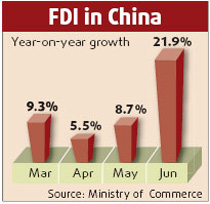The fourth China-ASEAN Expo (CAEXPO), slated for October 28-31, will focus on port development, official sources said.
This annual event will be held in Nanning, capital of Guangxi Zhuang Autonomous Region, featuring topics ranging from port development and cooperation between China and ASEAN, social development and poverty eradication, cooperation over power for homes and businesses, to cooperation and sustainable development in forestry, said Zheng Junjian, deputy secretary-general of the Secretariat for China-ASEAN Expo.
But the overriding theme of this year's CAEXPO will be port development and cooperation. To underline the theme a large model of an ocean liner has been created in the open-air plaza outside the international exhibition center in Nanning, the permanent venue of CAEXPO.
CAEXPO organizers have invited ministers of transportation from 10 ASEAN member states, their Chinese counterpart Li Shenglin, as well as government officials of key port cities of ASEAN and China, corporate executives of port affairs and logistics companies, shipping businesses, shipbuilding and repair firms, harbor investors to attend a forum where participants will exchange views and publish opportunities for regional port cooperation, said the CAEXPO Secretariat sources.
"Through our careful preparation efforts, I hope participants to this year's CAEXPO will be well informed of progress towards the establishment of a China-ASEAN free trade zone and the development in Pan-Beibu Gulf cooperation," said Li Jinzao, vice chairman of Guangxi Zhuang Autonomous Region.
More than 700 exhibitors from ASEAN and China will attend this year's CAPEXPO.
ASEAN (the Association of Southeast Asian Nations), established on August 8, 1967 in Bangkok, now groups Indonesia, Malaysia, the Philippines, Singapore, Thailand, Brunei, Vietnam, Laos, Myanmar and Cambodia.
China and the 10 ASEAN members are speeding up tariff reduction to facilitate the establishment of the China-ASEAN free trade zone.
China's average tariff on ASEAN goods has been slashed from 9.9 percent to 5.8 percent and will further drop to 2.4 percent by 2009. By the time the free trade zone is established, 93 percent of products from ASEAN countries will be tariff-free.
China aims to establish free trade zone with Brunei, Indonesia, Malaysia, the Philippines, Singapore and Thailand by 2010. Free trade zones with Vietnam, Laos, Cambodia and Myanmar are expected to be in place by 2015.
Zhang Xiaoqin, secretary general of China-ASEAN Expo Secretariat, said China and ASEAN have seen fast growth in bilateral trade in recent years.
According to Zhang, China-ASEAN trade volume was US$160.8 billion last year, while in the first eight months this year, bilateral trade amounted to US$127.95 billion. The bilateral trade volume between China and ASEAN is expected to reach US$190 billion this year.
(Xinhua News Agency October 24, 2007)


